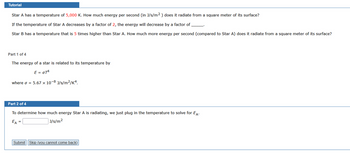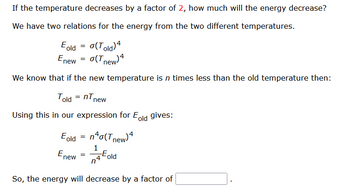
College Physics
11th Edition
ISBN: 9781305952300
Author: Raymond A. Serway, Chris Vuille
Publisher: Cengage Learning
expand_more
expand_more
format_list_bulleted
Concept explainers
Question

Transcribed Image Text:Tutorial
Star A has a temperature of 5,000 K. How much energy per second (in J/s/m2) does it radiate from a square meter of its surface?
If the temperature of Star A decreases by a factor of 2, the energy will decrease by a factor of
Star B has a temperature that is 5 times higher than Star A. How much more energy per second (compared to Star A) does it radiate from a square meter of its surface?
Part 1 of 4
The energy of a star is related to its temperature by
E = GT4
where σ = 5.67 x 10-8 J/s/m2/K4.
Part 2 of 4
To determine how much energy Star A is radiating, we just plug in the temperature to solve for EA.
EA =
J/s/m²
Submit Skip (you cannot come back)
Expert Solution
This question has been solved!
Explore an expertly crafted, step-by-step solution for a thorough understanding of key concepts.
This is a popular solution
Step 1: Determine the given data:
VIEW Step 2: Determine the energy radiated by the star per unit area:
VIEW Step 3: Compare the energy radiation if the temperature of the star decreases by factor 2:
VIEW Step 4: Compare the energy radiation of star B when its temperature is 5 times:
VIEW Solution
VIEW Trending nowThis is a popular solution!
Step by stepSolved in 5 steps with 5 images

Follow-up Questions
Read through expert solutions to related follow-up questions below.
Follow-up Question

Transcribed Image Text:Star B has a temperature that is 5 times higher than Star A. How much more energy per second (compared to Star A) does it radiate from a square meter of its surface?
EA = O(TA) 4
EB = σ(TB)4
Again, we know that Star B's temperature is n times Star A's.
TB = nTA
EB = σ(NTA) 4
So in terms of Star A's energy, Star B's is:
EB =
EA
Solution
by Bartleby Expert
Follow-up Question

Transcribed Image Text:If the temperature decreases by a factor of 2, how much will the energy decrease?
We have two relations for the energy from the two different temperatures.
Eold = o(Told) 4
Enew = o(Tnew) 4
We know that if the new temperature is n times less than the old temperature then:
Told =nTn
Using this in our expression for Eold gives:
Eold = n²o(Tnew) 4
1
-Eold
En
new
new
=
n
So, the energy will decrease by a factor of
Solution
by Bartleby Expert
Follow-up Questions
Read through expert solutions to related follow-up questions below.
Follow-up Question

Transcribed Image Text:Star B has a temperature that is 5 times higher than Star A. How much more energy per second (compared to Star A) does it radiate from a square meter of its surface?
EA = O(TA) 4
EB = σ(TB)4
Again, we know that Star B's temperature is n times Star A's.
TB = nTA
EB = σ(NTA) 4
So in terms of Star A's energy, Star B's is:
EB =
EA
Solution
by Bartleby Expert
Follow-up Question

Transcribed Image Text:If the temperature decreases by a factor of 2, how much will the energy decrease?
We have two relations for the energy from the two different temperatures.
Eold = o(Told) 4
Enew = o(Tnew) 4
We know that if the new temperature is n times less than the old temperature then:
Told =nTn
Using this in our expression for Eold gives:
Eold = n²o(Tnew) 4
1
-Eold
En
new
new
=
n
So, the energy will decrease by a factor of
Solution
by Bartleby Expert
Knowledge Booster
Learn more about
Need a deep-dive on the concept behind this application? Look no further. Learn more about this topic, physics and related others by exploring similar questions and additional content below.Similar questions
- Imagine a planet orbiting a star. Observations show a Doppler shift in the star's spectrum of 58 m/s over the 3.3 day orbit of the planet. What is the mass of the planet in kg? Assume the star has the same mass as the Sun (2.0 x1030 kg), there are 365.25 days in a year, and 1AU = 1.5 x 1011 m.arrow_forwardThe star Procyon A has an apparent magnitude of 0.38 and an absolute magnitude of 2.66 while the star Ross 128 has an apparent magnitude of 11.1 and an absolute magnitude of 13.5. Which star emits more energy? A. Procyon A O B. Ross 128 O C. They emit pretty much the same energy. D. There is insufficient information to tell.arrow_forwardWhat is the luminosity of a star having four times the radius of the Sun and a surface temperature of 8,000 K?arrow_forward
- An astronomer observes several stars with different colors. Rank them in order from highest temperature to lowest temperature. 1 is the highest temperature, 2 is the next highest, 3. Third highest, 4. lowest temperature orange-red star bluish-white star yellowish-white star red stararrow_forwardSuppose that two stars in a binary star system are separated by a distance of 80 million kilometers and are located at a distance of 160 light years from earth. What is the angular separation of the two stars? Give your answer in arcsecondsarrow_forward12. A star with spectral type MO has a surface temperature of 3750 K and a radius of 0.63 Rsun: How many times more luminous is this star than the Sun? (if it is less luminous enter a number less than one) Answer: Submit All Answers Last Answer: 0.0923 Incorrect, tries 1/5. Hint: Use the Luminosity equation, which says that L is proportional to R^2 T^4. If you keep these as ratios compared to the sun, your L will also come out as a ratio compared to the Sun. This star has a mass of 0.4 Msun- Using the simple approximation that we made in class, what is the main sequence lifetime of this star? You may assume that the lifetime of the sun is 1010 yr. Answer: Submit All Answers Compare this to the lifetime of a MO star listed in Table 22.1 (computed using a more sophisticated approach). Is the value you calculated in the previous problem longer or shorter than what is reported in the table? (L for longer, S for shorter) (You only get one try at this problem.) Answer: Submit All Answersarrow_forward
- A star is listed in a catalog as being a type G2V.a) What is the star’s spectral class?b) What is the star’s luminosity class?c) What is the peak color of the star?d) Name an example of a star that has this type.arrow_forwardEarth tugs the Sun around as it orbits, but it affects the radial velocity of the sun by only 0.09m/s. How large a shift in wavelength does this cause in the Sun's spectrum at 575 nm?arrow_forwardIf Star A's temperature is 5000 K and Star B's wavelength of peak emission is 5/7 as long as that of Star A, what is the temperature of Star B (in K; don't write the units in the text box)?arrow_forward
arrow_back_ios
arrow_forward_ios
Recommended textbooks for you
 College PhysicsPhysicsISBN:9781305952300Author:Raymond A. Serway, Chris VuillePublisher:Cengage Learning
College PhysicsPhysicsISBN:9781305952300Author:Raymond A. Serway, Chris VuillePublisher:Cengage Learning University Physics (14th Edition)PhysicsISBN:9780133969290Author:Hugh D. Young, Roger A. FreedmanPublisher:PEARSON
University Physics (14th Edition)PhysicsISBN:9780133969290Author:Hugh D. Young, Roger A. FreedmanPublisher:PEARSON Introduction To Quantum MechanicsPhysicsISBN:9781107189638Author:Griffiths, David J., Schroeter, Darrell F.Publisher:Cambridge University Press
Introduction To Quantum MechanicsPhysicsISBN:9781107189638Author:Griffiths, David J., Schroeter, Darrell F.Publisher:Cambridge University Press Physics for Scientists and EngineersPhysicsISBN:9781337553278Author:Raymond A. Serway, John W. JewettPublisher:Cengage Learning
Physics for Scientists and EngineersPhysicsISBN:9781337553278Author:Raymond A. Serway, John W. JewettPublisher:Cengage Learning Lecture- Tutorials for Introductory AstronomyPhysicsISBN:9780321820464Author:Edward E. Prather, Tim P. Slater, Jeff P. Adams, Gina BrissendenPublisher:Addison-Wesley
Lecture- Tutorials for Introductory AstronomyPhysicsISBN:9780321820464Author:Edward E. Prather, Tim P. Slater, Jeff P. Adams, Gina BrissendenPublisher:Addison-Wesley College Physics: A Strategic Approach (4th Editio...PhysicsISBN:9780134609034Author:Randall D. Knight (Professor Emeritus), Brian Jones, Stuart FieldPublisher:PEARSON
College Physics: A Strategic Approach (4th Editio...PhysicsISBN:9780134609034Author:Randall D. Knight (Professor Emeritus), Brian Jones, Stuart FieldPublisher:PEARSON

College Physics
Physics
ISBN:9781305952300
Author:Raymond A. Serway, Chris Vuille
Publisher:Cengage Learning

University Physics (14th Edition)
Physics
ISBN:9780133969290
Author:Hugh D. Young, Roger A. Freedman
Publisher:PEARSON

Introduction To Quantum Mechanics
Physics
ISBN:9781107189638
Author:Griffiths, David J., Schroeter, Darrell F.
Publisher:Cambridge University Press

Physics for Scientists and Engineers
Physics
ISBN:9781337553278
Author:Raymond A. Serway, John W. Jewett
Publisher:Cengage Learning

Lecture- Tutorials for Introductory Astronomy
Physics
ISBN:9780321820464
Author:Edward E. Prather, Tim P. Slater, Jeff P. Adams, Gina Brissenden
Publisher:Addison-Wesley

College Physics: A Strategic Approach (4th Editio...
Physics
ISBN:9780134609034
Author:Randall D. Knight (Professor Emeritus), Brian Jones, Stuart Field
Publisher:PEARSON